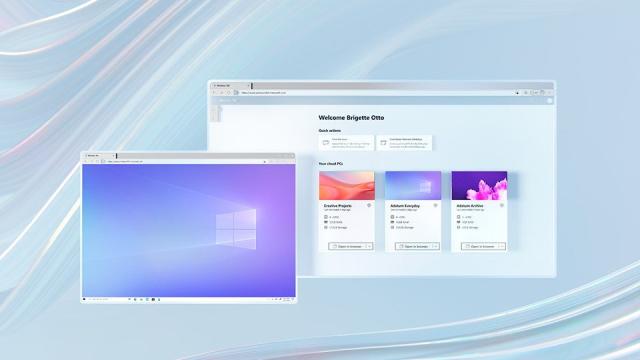After Office and Xbox, Microsoft went ahead and put Windows in the cloud. With the Windows 365 service, businesses will be able to stream Windows devices directly from Microsoft’s servers — like Netflix, but for your work computer.
Unlike a server farm, these will be individual instances of Windows machines, running with a unique and customisable set of apps and user data that can be streamed on any device (including phones and tablets). If your internet connection can stream a movie, it can stream Windows as well.
What comes with Windows 365 Cloud PC?
With Windows 365, businesses can create accounts for up to 300 users, each with their own instance of Windows PC (Windows 10 for now, and Windows 11 when it’s released). Plans start at $US24 ($32) per user per month ($US20 ($27) if you have a Windows 10 licence under the Windows Hybrid Benefit plan) for a single-core virtual CPU, 2GB RAM, and 64GB storage. The dual-core virtual CPU plan with 4GB storage and 64GB storage starts at $US32 ($43) per user per month.
And the prices go up quickly from there. The top-end eight-core virtual CPU with 32GB RAM and 512GB storage will cost you $US162 ($219) per user per month.
That said, Windows 365 is quite a unique service. While there are third-party services that let you run Windows on their data centres, no one offers an integrated experience like Microsoft does. Here, the account admin doesn’t need to do much to set up a user with Windows 365 — all they have to do is log into the admin interface, create an instance, assign it to a user, customise it based on the business’s needs, and they’re done. Windows 365 will then do the heavy lifting of installing and creating the instance, updating software, installing OS updates, and patching security issues.
While the asking rate of $US32 ($43)/month might seem like a lot, here’s what a Windows 365 subscription gets you:
- Software updates: Automatic, safe installation of software updates, including security patches.
- No setup: You won’t need an entire IT team to set up, monitor, and update devices. Microsoft will do that for each instance in the background.
- Really fast internet connection: The internet connection at Microsoft’s data centres is really fast. Things like downloading files and updates will happen in an instant.
- One state everywhere: Windows 365 will run in any browser on any device. Plus there are dedicated Microsoft Remote Desktop apps for iPhone, iPad, Android, Mac, and Windows. And no matter which device to access Windows 365 from, the computer will be in the same state, with the same data.
- Easily extensible: Windows 365 can scale with the requirements of your business. You can start with the base configuration, and as your needs change, you can increase the RAM, core count, or storage.
Should you pay for Windows 365 Cloud PC?
That brings us to the question: Who is this for? It’s not for consumers, or independent professions. Microsoft only offers this service for business and enterprise clients — and even if you talk about business users, there’s a very narrow set of use cases where it would be a perfect fit.
First of all, the service only supports 300 users, so big organisations are out. It’s the same case if a business wants to host/control its own instance of Windows; it’s just not possible in Windows 365. Ultimately, Windows 365 is for businesses that value seamless experience with little overhead, over everything else.
If you’re running a business with a couple of dozen employees, in a distributed team, but you still want to control the Windows experience for all users yourself (without a large IT team), this might be a good idea for you. You can get away by issuing cheap laptops, because the entire Windows experience will now run in the cloud. That is, if you don’t mind the $US30 ($41)-40 per user per month fee.
Cheaper alternatives to Windows 365
The scenario we described above is quite a narrow one — and even that isn’t exactly cost-effective. If you take a three-year timeline, the base two-core plan will cost you $US1152 ($1,559) in total, per user. You can get a decent mid-range laptop from Dell for, say, $US500 ($676) (or cheaper if you go for a refurbished model).
If you really need to offer remote desktop features to your employees, an AnyDesk subscription comes in at $US9.99 ($14) per month per user. Need control over the entire experience? Microsoft’s own Azure Virtual Desktop will let you create and host custom Windows 10 cloud PCs. Like all business decisions, this one might just come down to the cost. Before you make the decision, do the maths to see if it’s the best choice for you.
Editor’s Note: Australian pricing and availability for Windows 365 is still to be confirmed.

Leave a Reply
You must be logged in to post a comment.